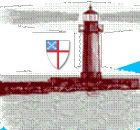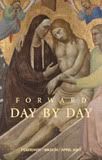St. James' Episcopal Church
Goshen, Indiana
Our 164th Year
Tuesday, July 15, 2008
Sermon for July 20th, 2008
Sermon for July 20, 2008
Proper 11, A
St. James’ Goshen IN
Arthur Hadley
In today’s Gospel we have heard the parable of the Wheat and the Tares. How lucky we are in the timing of the lectionary; we have harvested wheat this week. Those big combines turn through the fields cutting, thrashing, winnowing the wheat grains from the straw that is left behind in the field. What a difference mechanization makes. In the past first the wheat would have been cut and tied into bundles and then stacked into shocks. Later the shocks would have been gathered and thrashed. In the Middle East some thrashing is still done by putting the shocks of wheat bundle by bundle on the stone thrashing floor and having an ox or ass pull a wooden sled over the wheat separating the grain from the straw. The straw was removed from the stone thrashing floor, revealing the grain and the chaff, the dry covering of the grain. The chaff was removed from the grain by winnowing, tossing the chaff and grain into the air and letting the wind blow away the light chaff and heavier grain falling back to the thrashing floor.
If weeds grew in the wheat field, then the weeds had to be separated from the wheat before thrashing. The two most common weeds growing in the wheat fields of the Middle East are Syrian scabiosa, a smaller version of the garden blue scabiosa daisy, and a grass that grows much like wheat but has seed about half the size of wheat. The scabiosa seed is extremely bitter and the grass seed was thought to be poisonous.
So in the story Jesus told, the Sower of last week had sowed the wheat and Tares; weeds came up in the field. What should they do? Go out and pull the weeds or wait until the wheat was harvested. The wise owner told them to wait until harvest, then the wheat can be separated from the weeds. So the thrashing floor became the point of separation, separating the weeds from the wheat, and then separating the wheat grain from the straw, and finally separating the grain from the chaff that surrounded the wheat grain in the ear or head of wheat. To be very sure that the wheat grain was clean of all chaff, and to kill any insect eggs laid on the grains of wheat, those little insects that we all know as wheat weevil, the final step of the grain harvest was to make a fire of the wheat straw and toss the grain through the fire. The chaff would burn with a great flash, the heavier grain would pass through the flames and the evil weevil eggs would be killed in the flash of flame.
Jesus used this simple every day story of harvest to describe the coming of the Kingdom of God. That grain that was sowed and yielded 30, 60 even 100 fold, would be harvested by the master. The weeds that grew up with the good wheat would be separated and burned in the fire. That would further clean the good from the chaff and evil weevil that could cause ruin to the good wheat.
Each of us sin. We live in a world of sinfulness. But God, like the master of the field, can separate the good from the bad. Taking the sin and evil in the world in which we live, and burning it away like the chaff and separating us from the evil weevil that is on us, leaves us pure and holy for the Kingdom of God. Our sin is taken away.
Thanks be to God.
Subscribe to Posts [Atom]








